Ever since I got my first DNA test results in 2010 I have been researching my Cape Verdean roots from several angels. Of course everything starts with personal genealogy. But for deeper understanding I also take into account: population genetics, historical demography and cultural retention. In 2014 I created a website exactly with this purpose in mind: CVRAIZ: Specifying The African Ethnic Origins for Cape Verdeans. In that same year I also started a separate blog called Tracing African Roots. I have used this blog for taking a broader perspective. Among other things also aiming to apply a comparative analysis to see how Cape Verde fits in the broader picture of the Afro-Diaspora.
Right from the start in 2010 I have been actively engaging with other DNA testers on online forums, Facebook and also by way of sharing profiles etc.. This is how I was able to have access to an ever growing collection of Cape Verdean personal DNA test results. As well as from other parts of the Afro-Diaspora and mainland Africans. This has given me an invaluable opportunity to explore the regional African origins of people from across the Afro-Diaspora. And additionally also to gain greater insight into Cape Verdean genetics by way of survey-based research.1
Table 1 (click to enlarge)

***
I discovered the indispensable Slave Voyages website around the same time I received my own 23andme results in 2010. And ever since I have often relied heavily on the Trans-Atlantic Slave Trade Database as some sort of baseline. To establish historical plausibility within my ongoing research efforts on how personal DNA test results (regional admixture & African DNA matches) of Cape Verdeans and other Afro-Diasporans may already be in alignment with historical expectations.2
On this page I will merely post a brief summary of my main surveyfindings based on 23andme results.3 Please read the original blogposts for more detailed discussion, incl. methodology and relevant disclaimers:
- Ethnic group matches on 23andme for 50 Cape Verdeans (Fonte Felipe, 2022)
- 100 Cape Verdean 23andme results (Fonte Felipe, 2021)
- 23andme’s African breakdown put to the test: Afro Diaspora edition! (Fonte Felipe, 2021)
- Countries of Ancestry tool (IBD matching) (Fonte Felipe, 2015)
***
1) Ethnic group matches on 23andme for 50 Cape Verdeans (2022)
Figure 1.1 (click to enlarge)
Source: 23andme. This screenshot features the so-called genetic group results of a Cape Verdean. Realistically speaking practically all Cape Verdeans should have both Mandinga and Fula/Wolof lineage, due to endogamy and shared African roots. In fact the “Senegambian & Guinean” ancestors of this person and other Cape Verdeans should also include other additional ethnic origins as well. Such as Sereer, Balanta, Jola etc.. Just because these groups are undetected or not covered yet by 23andme’s database doesn’t mean it couldn’t be there!
____________________
“Earlier this month 23andme released its most recent update which could very well signal the start of a truly game-changing feature for zooming into ethno-linguistic African lineage. Going beyond the broad regional admixture categories such as “Nigerian” and “Senegambian & Guinean”. Which are already quite useful in fact. However by now providing much more granularity 23andme is really stepping up its game! For more details read this announcement by 23andme:
Of course this new feature on 23andme, based on matching strength, is not perfectly flawless. However despite a few shortcomings I am very excited about this update on 23andme! Because based on more than 50 updated results for Africans (see this overview) I am quite impressed with the accuracy of this tool. Also the results I have seen for 50 Cape Verdeans and 100 African Americans are actually in line with historical plausibility.” (Fonte Felipe, 2022)
____________________
Table 1.1 (click to enlarge)
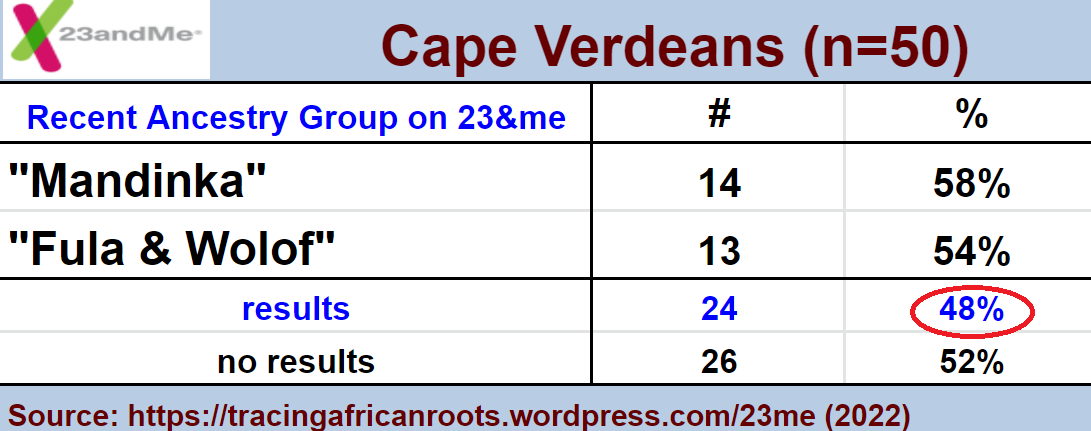
***
____________________
“To be kept in mind is that this does not say anything per se about the overall proportion of this “Fula & Wolof” or “Mandinka” lineage. Further research is needed to establish how much African lineage for Cape Verdeans is tracing back to earlier centuries and also from other ethnic groups (such as Papel, Biafada, Jola etc.). Because right now such lineage is undetected by 23andme’s matching algorithm and not covered by 23andme’s database.” (Fonte Felipe, 2022)
“Of course this update by 23andme is already very valuable for confirming especially Fula and Mandinga lineage. However do not forget that according to Cape Verde’s well respected historian António Carreira there are at least 27 historically attested African ethnic groups for Cape Verde! This historical evidence is mostly dating from the 1500’s/1600’s and overwhelmingly referring to ethnic groups from all over Upper Guinea. Not just the area of “Senegambia & Guinea”, but also extending into northern Sierra Leone in fact!” (Fonte Felipe, 2022)
“On a final note Table 1.1. above also shows that 24 out of 50 of my Cape Verdean survey participants received an ethnic group match (a few received more than 1). Hence the odds of receiving this update (~50%) are quite good. Especially when compared with African Americans for whom there only seems to be a 20% chance from my findings. This outcome, although again preliminary, is still interesting. As it seems to suggest that mainland African lineage for Cape Verdeans is at times still quite recent (1700’s-1800’s).” (Fonte Felipe, 2022)
____________________
2) 100 Cape Verdean 23andme results (2021)
Figure 2.1 (click to enlarge)
***

***
Table 2.1 (click to enlarge)

***
Table 2.2 (click to enlarge)

***
Table 2.3 (click to enlarge)

____________________
“My survey findings shown above are yet again confirming the overwhelmingly Upper Guinean roots for Cape Verdeans! Something which was already established by my first publication of Cape Verdean DNA results in 2015 (see this page). The so-called “Senegambian & Guinean” region serving as a primary signature region for pinpointing Upper Guinean lineage among all my Cape Verdean survey participants. Quite similar to the equivalent “Senegal” region on Ancestry. But more predictive when comparing with Ancestry’s 2013-2018 version. The group average for “Senegambian & Guinean” being 73.1% of their scaled African breakdown for 100 Cape Verdeans. As shown in the charts above. While on Ancestry the scaled group average of “Senegal” for 100 Cape Verdeans was 58.7% (see this chart).
But also so-called “Ghanaian, Liberian & Sierra Leonean” scores were most likely describing an additional part of Upper Guinean DNA. As suggested by the labeling to be associated first of all with historically plausible lineage from Sierra Leone. In fact 23andme uses Temne reference samples (see this overview) and this ethnic group from northern Sierra Leone has significant historical and cultural/linguistic connections with Cape Verde (referred to as “Sape”, see this page). But most likely this region is also partially to be associated with DNA from Mali and Senegambia as shown in Table 6.” (Fonte Felipe, 2021)
____________________
Table 2.4 (click to enlarge)
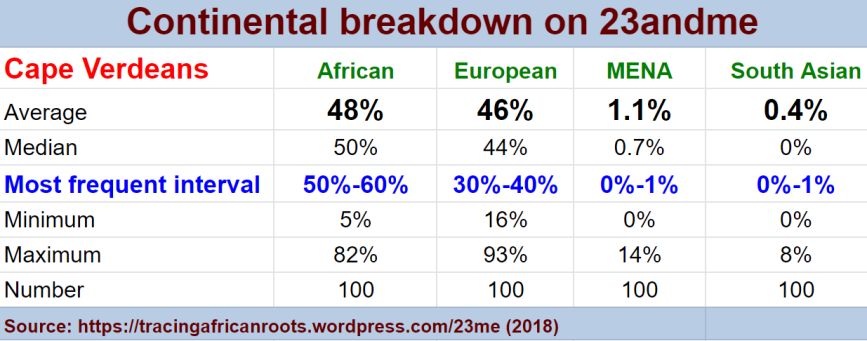
***
Table 2.5 (click to enlarge)

***
Table 2.6 (click to enlarge)
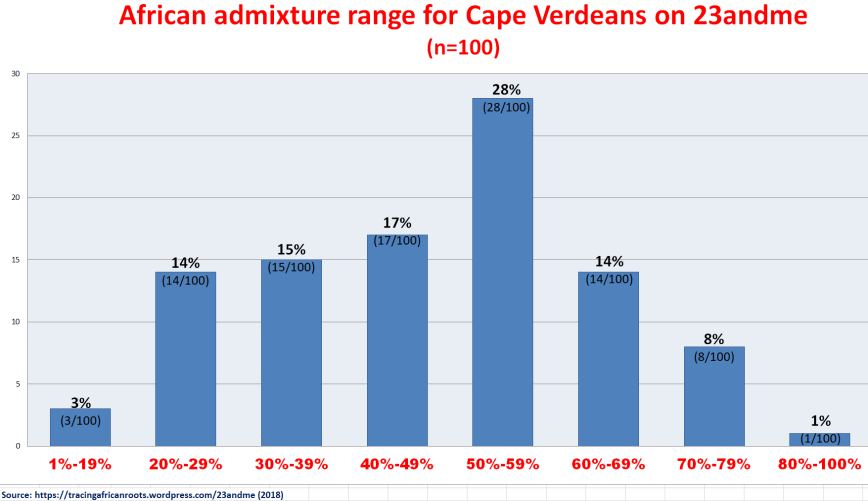
____________________
“The group averages are displaying a remarkable balance between African & European admixture. Practically 50/50 proportions. This thorough racial blending marks a key aspect of not only Cape Verdean genetics but also Cape Verdean creolized culture and Caboverdianidade. One should be careful though to exclusively equate the Creole a.k.a. Crioulo identity of all Cape Verdeans with being racially mixed per se, or at least not in balanced proportions. The all-inclusive Crioulo identity of Cape Verdeans (regardless of racial appearance or DNA results) is often misunderstood by outsiders which causes them to apply it for inappropriate and potentially divisive racial classifications.” (Fonte Felipe 2018)
“Santiago unfortunately remains undersampled […] while other CV islands have been overrepresented. […] My own research is of course very much done on a best-effort basis. And especially in previous years (2015-2018) there were simply very few DNA testers from Santiago around. Luckily this has been changing gradually. Especially now that DNA testing is getting popular in Portugal as well there are more Santiago test results available. I have always tried to point out such sampling bias in the disclaimers of my blog posts.” (Fonte Felipe, 2023)
“Then again, the Cape Verdean Diaspora is often said to be more numerous than the actual island population. And to truly do justice to the full spectrum of Cape Verdean diversity one should take them into consideration as well. Especially because due to historical reasons and so-called chain-migration many Cape Verdean descendants abroad might have stronger links with specific islands (such as Fogo and Brava in the USA, Santiago in Portugal and Barlavento in Northwest Europe). And therefore their combined average DNA profiles might also deviate somewhat from the national average in Cape Verde itself.” (Fonte Felipe, 2024)
____________________
3) 23andme’s African breakdown put to the test: Afro Diaspora edition! (2021)
Figure 3.1 (click to enlarge)
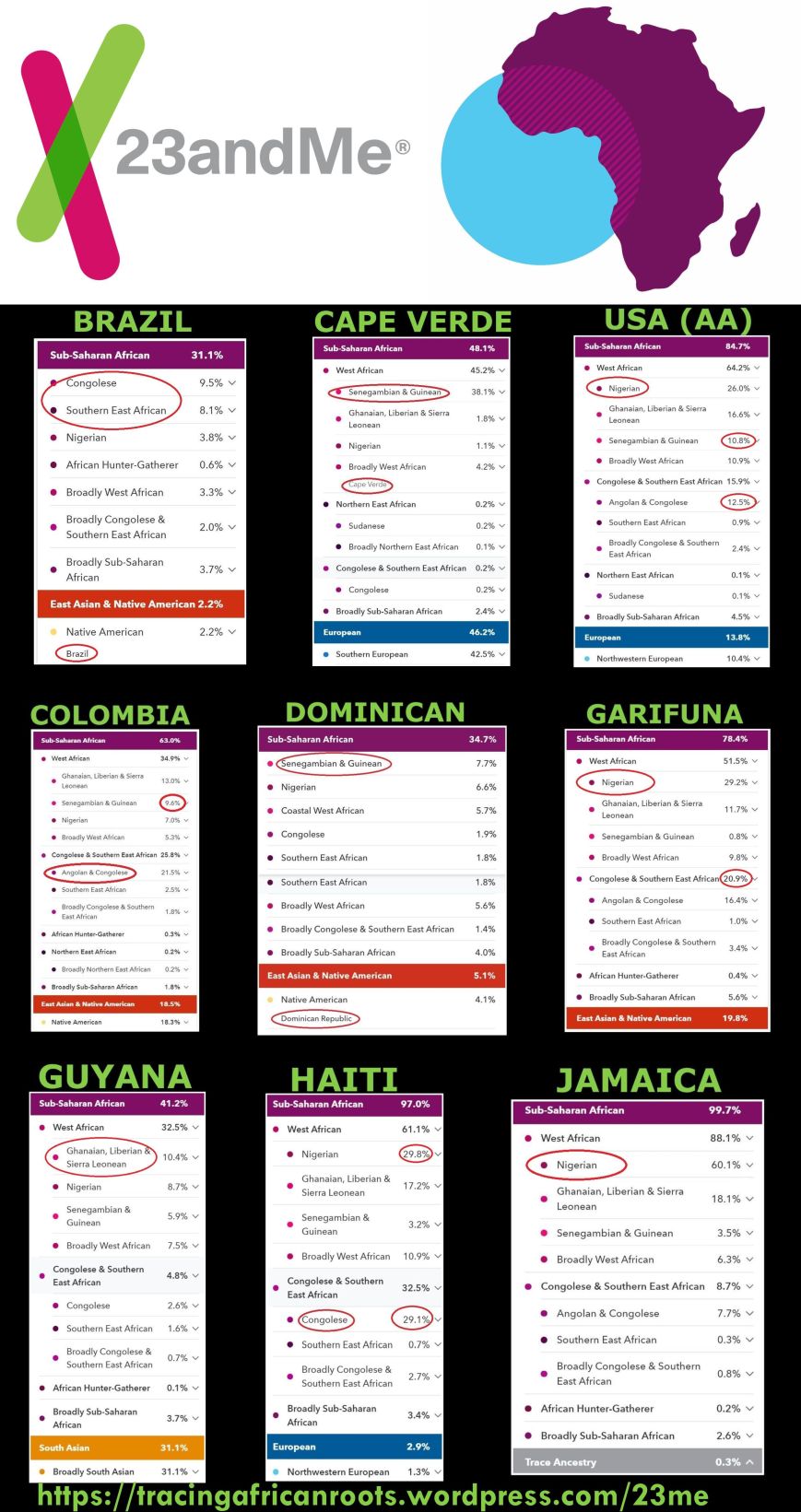
____________________
“Establishing where each African region is relatively more pronounced or instead more subdued might provide insightful clues for the unique ethnogenesis of each nationality being shown [..].” (Fonte Felipe 2015)
“But in this blog post I will at last present my main 23andme survey findings based on 889 results from 28 different countries across the Afro-Diaspora!” (Fonte Felipe, 2021)
“To summarize: I do indeed believe that 23andme’s African breakdown has passed the test! Although obviously there are several shortcomings to take into account. Based on both my African and Afro-Diasporan surveyfindings I find it quite impressive though that 23andme is often able to describe a person’s African origins in a meaningful regional framework. Which will usually quite closely correspond with either known genealogy or historical plausibility. The additional non-African scores and Recent Ancestral Locations actually reinforcing the robustness of 23andme’s predictions.” (Fonte Felipe, 2021)
“Generally speaking I would say that with its 2018/2019 version 23andme provided quite reliable estimates of especially Upper Guinean lineage by way of “Senegambian & Guinean”. Clearly manifested among Cape Verdeans. As well as among many Hispanic Americans, mostly due to an early Upper Guinean Founding Effect. Furthermore also among some of my Guyanese survey participants a relatively high “Senegambian & Guinean” level could be observed because actually some of them had distant Cape Verdean ancestry from the 1800’s! Providing a further corroboration of this category’s predictive accuracy.” (Fonte Felipe, 2021)
____________________
Table 3.1 (click to enlarge)
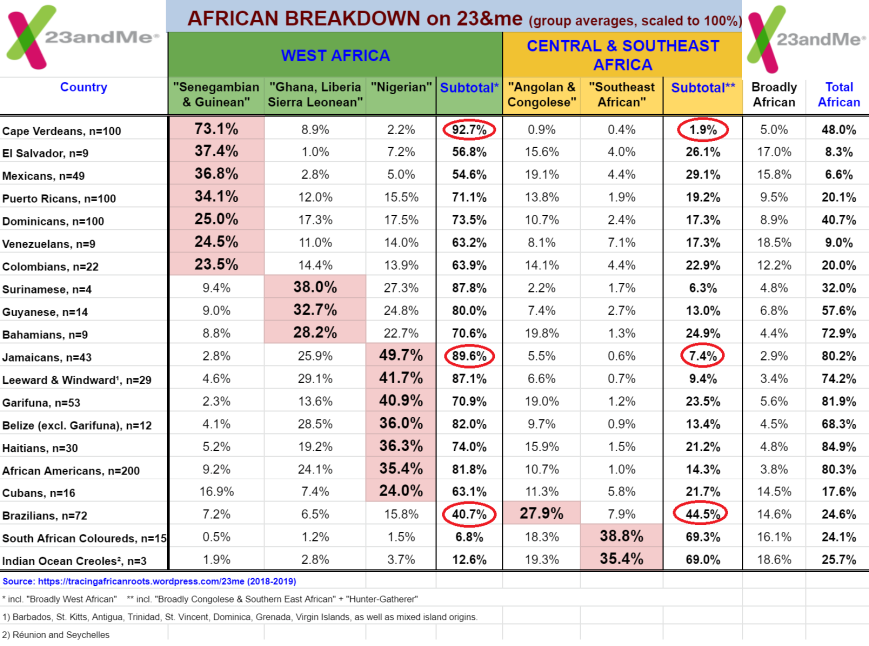
***
4) Countries of Ancestry tool (IBD matching) (2015)
____________________
“Countries of Ancestry (formerly known as Ancestry Finder) was a feature of the 23andMe Personal Genome Service. It was accessed from Ancestry Labs on the 23andMe user interface. Ancestry Finder Lab utilized the data collected from 23andMe customers in the survey entitled, “Where Are You From?” to chart the birth country of your autosomal DNA matches’ grandparents. The purpose was to attempt to give an overview of your ethnic origins by exploring those of your matches. The feature was made available to all 23andMe customers on July 8, 2010. It was retired in November 2015 when 23andMe began to roll out the launch of a new website.” (source: ISOGG)
“Despite all of the unknown variables involved I have always felt that with careful interpretation you can still obtain a great deal of informational value from 23andme’s CoA tool. I myself was able to connect with my first Cape Verdean DNA cousin through my CoA results (way back in 2010 already!). Also several Afro-Diasporans were able to find their very first African DNA matches by way of CoA. Going beyond individual results I have always been fascinated by the potential this CoA tool could have to uncover some generalized matching patterns between Africans and Afro-Diasporans. Being very anxious to learn if these patterns roughly corroborate what we know from historical sources and cultural retention.” (Fonte Felipe, 2015)
____________________
Countries of Ancestry results for a Cape Verdean (set at 5cM & 10cM, excl. USA)
***(click to enlarge)
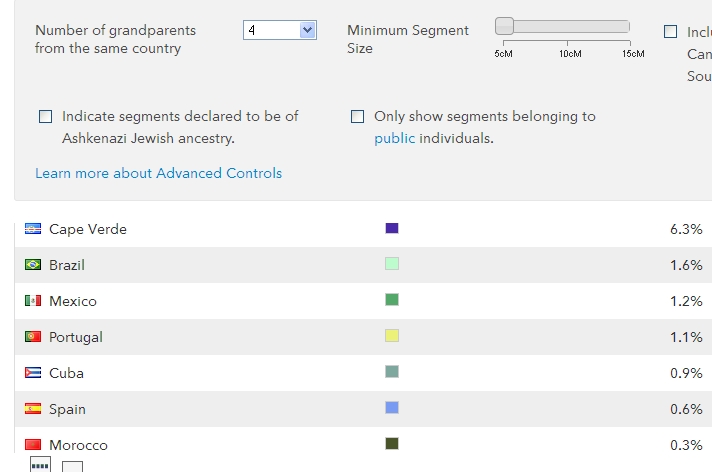
Notice how Cape Verde is correctly displayed as top ranking country. However aside from Morocco no other African countries are being shown. While Cape Verde’s shared Iberian ancestral connections are properly represented by Portugal, Spain and Latin American countries. Such a skewed outcome towards shared European lineage matches was pretty standard for other Afro-Diasporans as well. African DNA matches being prized rarities in this early timeperiod of personal DNA testing (2010-2015).
***(click to enlarge)
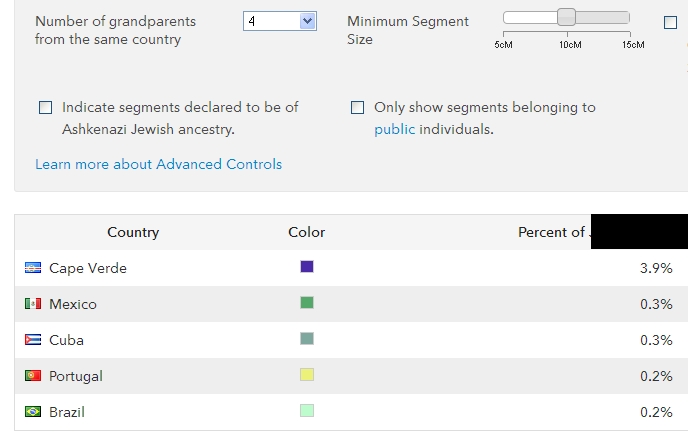
Basically the same ranking patterns being repeated. But with a higher degree of reliability because of the 10cM threshold. Due to historical plausibility shared Iberian/Portuguese lineage seems to be indicated firstmost. With MRCA’s not originating in Cape Verde but rather in Portugal or Spain. Although shared African lineage might theoretically also be a possibility in some cases.
***
African DNA matches for Cape Verdeans (2014)
Basically this Countries of Ancestry tool is detecting shared DNA segments which might be indicative of shared ancestry. Because generally speaking African origins for Cape Verdeans might date back 300-500 years, it is to be expected they will mostly share smaller segments with mainland Africans. The database of 23andme is consisting of its mostly USA-based customers and therefore very much lacking of any potentially African matches. From over 20 Cape Verdeans on 23andme only 4 persons showed any mainland African matches. See below for the screenshots. I was able to access this info because I am sharing profiles with them. [text adapted from 2014 version of this website]
Guiné Bissau
This is the biggest match, the Guinean person being a Mandinga ( I am also sharing profiles with him) and the Cape Verdean he’s matching is from Fogo. The shared DNA segment size is quite big, almost 9 cM. Perhaps a connection to a relatively late Mandinga presence in Cape Verde (1700’s/1800’s)?
Senegal
Seems to be the same DNA segment on chromosome 3 for 2 Cape Verdean persons who are only distant DNA cousins, not recently related. So perhaps this might be some ancient segment (1500’s) circulating/being recycled in the Cape Verdean genepool?
Gambia
___________________________________________________________________________
Notes
1) Due to source snobbery personal DNA testing results are not always fully appreciated for their informational value. I myself have never taken this overly dismissive stance. Preferring to judge each case on its own merits. From my observations especially 23andme and AncestryDNA are well-equipped to deliver results in line with the known or historically plausible backgrounds of Cape Verdeans as well as other Atlantic Afro-descendants. Of course correct interpretation and knowing how to really “read the data” remains a crucial requirement. For a more detailed discussion on the inherent restrictions of personal DNA test results see these pages:
- 23andme surveys (2011-ongoing)
- Ancestry surveys (regional admixture: 2013-2018)
- Ancestry surveys (DNA matches: 2017-ongoing)
2) The earliest summary of my Cape Verdean survey findings was put online in 2015. Which was (as far as I know) the first ever demonstration that Cape Verdeans are overwhelmingly Upper Guinean in origins. When looking only at their African DNA and based on autosomal genotyping. Previous haplogroup studies (see this link) did also come to the same conclusion. However they were restricted in the sense that they didn’t measure the complete, genomewide ancestry of Cape Verdeans but only focused on maternal lineages.
This finding was quite distinctive. In particular when contrasted/compared with other survey groups from across the Afro-Diaspora. Which I blogged about for the first time in 2016. This outcome has been replicated in all my subsequent surveys. Which also indicate a so-called Upper Guinean Founding Effect for many Hispanic Americans. Similar to Cape Verdeans also mostly to be traced back to the 1500’s. This is also something I established by way of surveybased research already in 2015.
Actually my very first survey efforts date back even earlier to 2011. Based on the pioneering African Ancestry Project by Razib Khan. I shared these findings also on 23andme’s online community at that time. They can still be seen in this online spreadsheet. Already then I was able to make good use of Cape Verdean DNA results as some sort of control group within a broader dataset of Afro-descendants. Albeit that of course the sample size was very minimal, given that personal DNA testing had not yet become popular.
This early research opened my eyes to the fact that Cape Verdeans form a special part of the Afro-Diaspora, given that their African roots are overwhelmingly from Upper Guinea. And this should also be reflected in their DNA results (if they are any good ). In this case a tellingly pronounced genetic affiliation with “Mandenka” showed up already in 2011 (see this overview)!
Unlike commonly assumed you do not need to sample entire populations to obtain informational value with wider implications. Naturally greater sample size does (usually) help matters. However I find it reassuring that in many aspects peer reviewed studies based on larger sample size have vindicated my own earlier findings. While due to free format on my blog I am often able to provide greater detail and more appropriate context.
In my latest survey efforts (based on both 23andme and Ancestry results) my Cape Verdean survey group has taken a more robust sample size of n=100. And in the near future I aim to expand especially the coverage of DNA results from Santiago, Maio, Boavista and Sal. Continued corroboration of my own research is not only to be seen in the DNA studies reviewed on this website. But also a few years ago my survey findings were replicated by the huge study performed by 23andme’s research team:
- Genetic Consequences of the Transatlantic Slave Trade in the Americas (Micheletti et al., 2020) (go to section 2 for Cape Verde related discussion)
To specify the overlap with my own research more clearly. See below for an overview of aspects about Cape Verdean genetics which I already established several years ago.
1) Cape Verdeans being mainly an Upper Guinean/Iberian mix: 2018, 2021
2) Interisland differentiation/substructure: 2015, 2018, 2021
3) Minor non-Upper Guinean lineage: 2015, 2018a, 2018b, 2021
4) Comparison with other parts of Afro-Diaspora: 2016, 2018a, 2018b, 2021
5) Recent ancestry (1800’s) from Portugal & Upper Guinea: 2018a, 2018b, 2022
Furthermore my own research has also gone beyond what has been published sofar by peer reviewed studies. In particular for these aspects:
1) IBD matching patterns (Ancestry, 23andme): 2018, 2022
2) Analysis of North African/Sephardi Jewish lineage: 2015, 2018a, 2018b
3) Analysis of South Asian and Amerindian lineage: 2018a, 2018b, 2021
4) Indications of Northwest European lineage: 2013, 2018, 2021
3) I have actually performed an earlier survey of Cape Verdean 23andme results based on the 2013-2018 version. Which still had a very basic African breakdown (see this page). This survey was started already in 2013. But I never blogged about it due to the lack of within-Africa specificity. The sample size is arguably not very large (n=32). Plus at that time I was not able yet to include any samples from Santiago or other underrepresented islands. Still useful for the continental breakdown. Including a most likely more realistic estimate of Middle Eastern & North African (MENA) admixture. And also interesting for the possibly overestimated but still distinctive North European component surfacing (9.7%). Notice how this dataset already shows substructure when comparing Barlavento (São Vicente, Santo Antão & São Nicolau) vs. Sotavento (Brava & Fogo). It also includes haplogroups. Follow this link below for my online spreadsheet:
***
***







